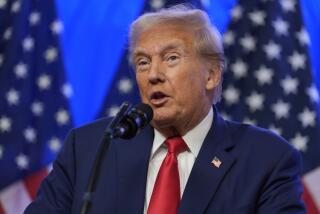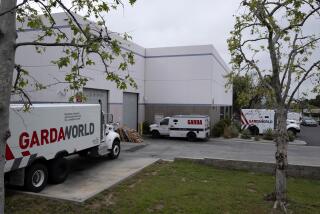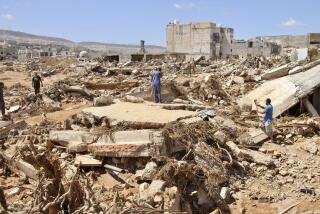As Libya takes stock, Moammar Kadafi’s hidden riches astound
- Share via
Reporting from Washington — Moammar Kadafi secretly salted away more than $200 billion in bank accounts, real estate and corporate investments around the world before he was killed, about $30,000 for every Libyan citizen and double the amount that Western governments previously had suspected, according to senior Libyan officials.
The new estimates of the deposed dictator’s hidden cash, gold reserves and investments are “staggering,” one person who has studied detailed records of the asset search said Friday. “No one truly appreciated the scope of it.”
If the values prove accurate, Kadafi will go down in history as one of the most rapacious as well as one of the most bizarre world leaders, on a scale with the late Mobutu Sese Seko in Zaire or the late Ferdinand Marcos in the Philippines.
PHOTOS: Moammar Kadafi | 1942-2011
Kadafi’s death after he was captured Thursday outside his birthplace, the coastal town of Surt, not only all but ended the armed uprising that erupted in February. Revelation of the stunning size of the portfolio may stir anger among Libya’s 6.5 million people — about one-third of whom live in poverty.
Though Kadafi’s foreign investments would seem to offer a bonanza for the transitional government, it is struggling to reclaim the money because of legal barriers created by a U.N. freeze on Libyan assets and national laws designed to ensure seized assets are only released to the legal owner.
U.S. and European authorities said Friday that they intended to quickly hand over frozen assets to the transitional Libyan government. But so far, the U.N. has authorized release of only $1.5 billion from accounts in the U.S., and the Obama administration has turned over $700 million of that amount, said Marti Adams, a Treasury Department spokeswoman.
Some African nations were reluctant to freeze Libyan accounts at all because of their loyalty to Kadafi. Others feared that freezing Libyan assets could hurt their domestic economies as bills and workers went unpaid.
During his 42 years in power, Kadafi steered aid and investment to benefit his own family and tribe, but denied support for much of the country, especially the eastern region that historically resisted his family’s despotic grip on power.
Obama administration officials were stunned last spring when they found $37 billion in Libyan regime accounts and investments in the United States, and they quickly froze the assets before Kadafi or his aides could move them.
Governments in France, Italy, England and Germany seized control of another $30 billion or so. Investigators estimated that Kadafi had stashed perhaps another $30 billion elsewhere in the world, for a total of about $100 billion.
But subsequent investigations by American, European and Libyan authorities determined that Kadafi secretly sent tens of billions more abroad over the years and made sometimes lucrative investments in nearly every major country, including much of the Middle East and Southeast Asia, officials said Friday.
Most of the money was under the name of government institutions such as the Central Bank of Libya, the Libyan Investment Authority, the Libyan Foreign Bank, the Libyan National Oil Corp. and the Libya African Investment Portfolio. But investigators said Kadafi and his family members could access any of the money if they chose to.
The new $200 billion figure is about double the prewar annual economic output of Libya, which has the largest proven oil reserves in Africa.
Officials of the transitional government point to the secret transfer of so much wealth as proof that Kadafi, who once gave himself the title “King of Kings,” had imperial ambitions for himself but little concern for most Libyans.
Kadafi was sending vast sums abroad “at a time when Libyans were struggling for the money they needed for schools, hospitals and all sorts of infrastructure,” said one person close to the council, who spoke on condition of anonymity because the investigations are ongoing.
Investigators believe Kadafi’s foreign investments accelerated in recent years. Almost all the assets and accounts found in the United States were from the last four or five years, after Kadafi surrendered a nascent nuclear weapons program and moved toward restoring full diplomatic relations with Washington.
In addition to the vast foreign investments, Kadafi is believed to have amassed billions of dollars in gold reserves inside Libya, possibly for use in case his rule was threatened. Western authorities believe Kadafi and his aides secretly maneuvered to bring some of the cash back to Tripoli to help pay for their war effort.
Secretary of State Hillary Rodham Clinton told an NBC interviewer Thursday that rebel forces had worried that Kadafi could still “be recruiting mercenaries, paying with the gold they believe he had absconded with.”
Western officials have struggled all year not only to identify Kadafi’s money but also to convince countries such as India, China and Russia to seize Libyan investments as required by a U.N. Security Council resolution.
Investigations last spring found Libyan regime investments in several high-profile Western ventures, including the Italian soccer club Juventus, the Italian bank UniCredit and the British publisher Pearson, which owns the Financial Times newspaper.
Officials now believe other assets include accounts held by Kadafi family members with money drawn from national oil sales.
Steven Cook, a Mideast specialist at the nonpartisan Council on Foreign Relations, said it was known that Kadafi had invested heavily in nearby African nations, since he sought to build and lead a pan-African alliance.
“But all this, of course, goes way beyond that,” Cook said.
FULL COVERAGE: The death of Moammar Kadafi
More to Read
Sign up for Essential California
The most important California stories and recommendations in your inbox every morning.
You may occasionally receive promotional content from the Los Angeles Times.











